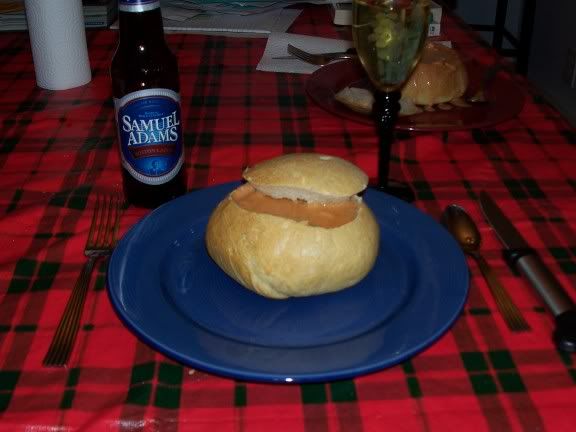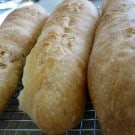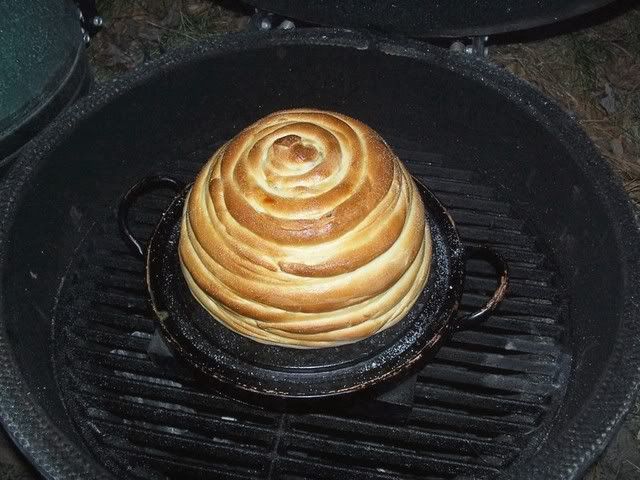Share your photos by tagging us and using the hashtag #BigGreenEgg.
Want to see how the EGG is made? Click to Watch
bread bowl help
JD
Comments
-
Me too...post it if you find one.Green egg, dead animal and alcohol. The "Boro".. TN
-
Mighty Quinn threw down some sour dough ones a while back that looked fantastic I will see if I can find them.
-
-
Looking back, other than the recipe, there isn't much detail on the bowls...tough for me to describe shaping the bowls, but it is just like you would do for a large boule but on a smaller scale..there are good YouTube videos on shaping bread.
-
this one i did in the egg on a raised rack with a little water flashing into steam in a pan under the stone at the start of each boule

the setup
Pain Ordinaire Careme
Yield: 4 baguettes, boules, or couronnes
Prep Time: 1 hour (active) 4 hours 30 minues (inactive)
Cook Time: 25 to 30 minutes
Total Time: 6 hours
Ingredients:
Ingredients:
6 cups bread or unbleached flour, approximately
2 packages dry yeast
2½ cups hot water (120-130 degrees F)
2 teaspoons each salt and waterDirections:
Baking Sheet or Pans: 1 baking sheet, teflon or greased and sprinkled with cornmeal, or 4 baguette pans, greased.
By Hand or Mixer: (10 mins)
The early part of this preparation, beating a batter, can be done by an electric mixer. However, don't overload a light mixer with this thick batter. If by hand, stir vigorously for an equal length of time.Measure 3 or 4 cups of flour into the mixing bowl and add the yeast and hot water. The mixer flat beater or whisk should run without undue strain. The batter will be smooth and pull away from the sides as the gluten develops. It may also try to climb up the beaters and into the motor. If it does, push it down with a rubber scraper. Mix for 10 minutes. When about finished, dissolve the salt in the water and add to the batter. Blend for 30 seconds or more.
Kneading (10 mins.):
If the machine has a dough hook, continue with it and add additional flour, ¼ cup at a time, until the dough has formed under the hook and cleans the sides of the bowl. If it is sticky and clings, add sprinkles of flour. Knead for 10 minutes.If by hand, add additional flour to the beaten batter, ½ cup at a time, stirring first with a utensil and then working by hand. When the dough is shaggy but a solid mass, turn onto a work surface and begin kneading with an aggressive push-turn-fold motion. If the dough is sticky, toss down sprinkles of flour. Break the kneading rhythm occasionally by throwing the dough down hard against the countertop - an excellent way to encourage the development of the dough.
First Rising (2 hours):
Place the dough in a large greased bowl, cover with plastic wrap, and leave at room temperature for 2 hours. The dough will more than treble in volume - and may even be pushing against the plastic covering.(If prepared with a new fast-rising yeast and at the recommended higher temperatures, reduce the rising times by about half.)
Second Rising (1½ hours):
Turn back the plastic wrap and turn the dough onto the work surface to knead briefly, about 3 minutes.Return the dough to the bowl and re-cover with wax paper. Allow to rise to more than triple its volume, about 1½ hours.
Shaping (10 mins)
The dough will be light and puffy. Turn it onto the floured work surface and punch it down. Don't be surprised if it pushes back, for it is quite resilient.Divide the dough into as many pieces as you wish loaves. One-quarter (10 oz) of this recipe will make a baguette 22" long and 3" to 4" in diameter.
Allow pieces of dough to rest for 5 minutes before shaping.
For boules or round loaves, shape the pieces into balls. Place in cloth-lined baskets (bannetons) or position directly on the baking sheet. For baguettes, roll and lengthen each dough piece under your palms to 16" to 20" , and 3" to 4" in diameter. Place in a pan or on a baking sheet or in the folds of a long cloth (couche).
This loaf's characteristic couronne or "crown" can be made in several ways. One is to flatten the piece of dough, press a hole through the center with your thumb, and enlarge the hole with your fingers. Another is to roll a long strand 18" to 24" and curl into a circle, overlapping and pushing together the ends. Yet a third way is to take 2 or 3 shorter lengths of dough and join them together in a circle, not overlapping top and bottom but pressing the ends together side by side into a uniform pattern - this one will be irregular but attractive.
Third rising (1 hour)
Cover the loaves with a cloth, preferably of wool, to allow air to reach the loaves and to form a light crust. Leave at room temperature until the dough has risen to more than double its size, about 1 hour.Preheat:
Before preheating the oven to 450 degrees F (very hot) 20 minutes before baking, place a broiler pan on the floor of the oven or bottom rack so it will be there later. Five minutes before baking, pour 1 cup hot water into the hot pan. Be careful of the burst of steam - it can burn. I use a long-handled cup to reach into the oven when I pour.Baking: (450 degrees F/25-30 mins.)
Carefully move the loaves in baskets and in couches to the baking sheet. Make diagonal cuts down the lengths of the long loaves and tic-tac-toe designs on the boules.Place on the middle shelf of the oven.
The loaves are done when a golden brown, 25 to 30 minutes. Turn one loaf over and if the bottom crust sounds hard and hollow when tapped, the loaf is done.
(If using a convection oven, reduce heat 50 degrees.)
Final step:
Place on a rack to cool.(Source: Bernard Clayton's New Complete Book of Breads
)
this one was a behive bowl, alot more work and i would have to dig the recipe up

fukahwee maineyou can lead a fish to water but you can not make him drink it
Categories
- All Categories
- 182.7K EggHead Forum
- 15.7K Forum List
- 459 EGGtoberfest
- 1.9K Forum Feedback
- 10.3K Off Topic
- 2.2K EGG Table Forum
- 1 Rules & Disclaimer
- 9K Cookbook
- 12 Valentines Day
- 91 Holiday Recipes
- 223 Appetizers
- 516 Baking
- 2.4K Beef
- 88 Desserts
- 163 Lamb
- 2.4K Pork
- 1.5K Poultry
- 30 Salads and Dressings
- 320 Sauces, Rubs, Marinades
- 543 Seafood
- 175 Sides
- 121 Soups, Stews, Chilis
- 35 Vegetarian
- 100 Vegetables
- 313 Health
- 293 Weight Loss Forum



